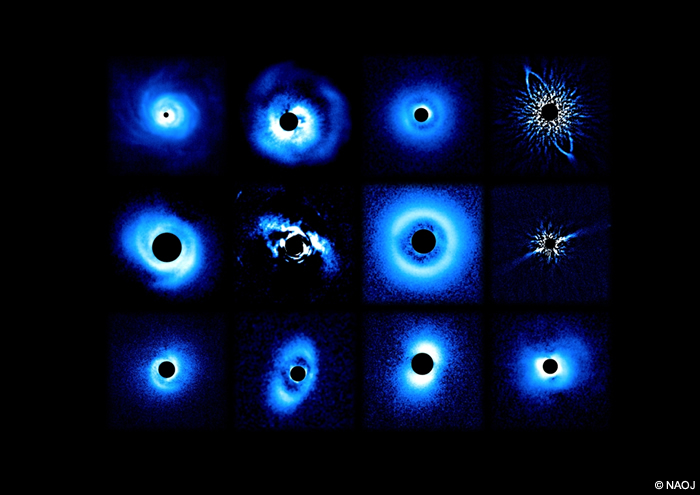HiCIAO Disk Gallery
Astrophotography・

| Object | Debris Disks and Protoplanetary Disks Surrounding Young Stars |
|---|---|
| Telescope | The Subaru Telescope |
| Instrument | HiCIAO |
| Wavelength | Near Infrared, 1.6 µm |
| Date | 2010 to 2012 |
| Copyright | National Astronomical Observatory of Japan |
This is a gallery of observationally imaged protoplanetary disks and debris disks taken with HiCIAO, a high contrast infrared camera developed for use with the Subaru Telescope, as part of the SEEDS Project. It is thought that the planets, including the Earth we live on, formed long ago in a disk enveloping the Sun. It is speculated that the complicated structures which we have now found in other disks are caused by mutual gravitational interactions between planets and the disks; indicating that planets like Jupiter and Earth are probably forming right now in those disks.
Formation Site of the First Planet to be found at the Scale of the Solar System
The SEEDS Project is a strategic observation program using the Subaru Telescope. It aims to advance observational research of extrasolar planets and the disks which serve as the sites of their formation. Most young stars are surrounded by disks rich in gas and solid particles (dust) which become the materials for planets. We feel it is important to observe disks at radii of dozens of Astronomical Units, the range where the Solar System planets reside, in order to understand the planet formation process. But because of the bright central star, up to now it has been very difficult to observe disks on the scale of the Solar System. HiCIAO’s polarization differential imaging mode was able to overcome these difficulties. It is thought that when a planet is born in a disk, spiral arms or gaps are formed by the mutual gravitational interactions between the planet and disk, creating intricate patterns in the disk. Therefore, we can say that by photographing diverse disk structures like those seen in this gallery, SEEDS has succeeded in taking pictures of locations where planets are likely forming on the scale of the Solar System.
Article written by: Jun Hashimoto (The University of Oklahoma)
Translation by: Ramsey Lundock (NAOJ)